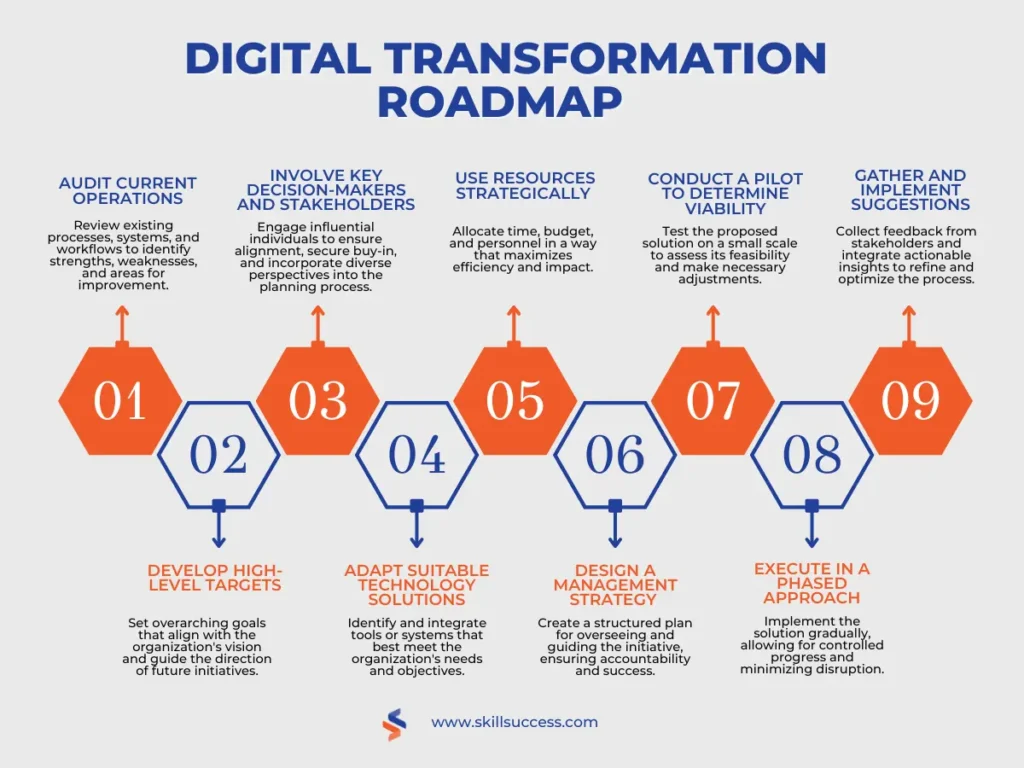Creating a digital transformation roadmap starts with a clear, strategic plan. From assessing your current digital capabilities to implementing innovative technologies, every step in this guide is designed to modernize operations, enhance efficiency, and align with your organizational goals.
With global spending on digital transformation expected to reach $3.9 trillion by 2027, it is clear that embracing digital solutions is no longer optional for businesses aiming to remain competitive. Along the way, tools like digital resource trackers, user feedback platforms, and online skill-building courses will ensure your transformation is both consistent and impactful.

Step 1. Audit Current Operations
Review existing processes, systems, and workflows to identify strengths, weaknesses, and areas for improvement.
Key actions to take:
- Review processes: Document workflows to spot inefficiencies and identify bottlenecks.
- Assess systems: Examine existing technology and tools for alignment with business goals.
- Identify strengths: Pinpoint areas where your team excels to leverage them effectively.
- Gather data: Analyze metrics such as customer satisfaction, employee productivity, and system performance to gain insights into your current state.
Step 2. Develop High-Level Targets
Set overarching goals that align with the organization's vision and guide the direction of future initiatives.
Key actions to take:
- Clarify priorities: Define measurable objectives that support your strategic vision.
- Align with long-term goals: Ensure that targets contribute to overall organizational success.
- Set benchmarks: Identify key performance indicators (KPIs) to track progress effectively.
- Establish timelines: Create a roadmap with clear deadlines to maintain focus and accountability.
Step 3. Involve Key Decision-Makers and Stakeholders
Engage influential individuals to ensure alignment, secure buy-in, and incorporate diverse perspectives into the planning process.
Key actions to take:
- Foster collaboration: Host workshops or meetings to encourage shared decision-making.
- Involve teams early: Engage stakeholders at the planning phase to increase investment in outcomes.
- Maintain communication: Create channels to keep stakeholders informed and involved.
Step 4. Adapt Suitable Technology Solutions
Identify and integrate tools or systems that best meet the organization's needs and objectives.
Key actions to take:
- Evaluate technology needs: Assess potential tools for scalability and alignment with goals.
- Use cloud-based solutions: Opt for flexible, scalable platforms that support digital growth.
- Ensure integration: Confirm that new technologies work seamlessly with existing systems.
Step 5. Use Resources Strategically
Allocate time, budget, and personnel in a way that maximizes efficiency and impact.
Key actions to take:
- Prioritize tasks: Focus on high-impact initiatives to optimize results.
- Allocate personnel effectively: Match team skills with project needs.
- Monitor budgets: Regularly track financial allocations to maintain cost-effectiveness.
Step 6. Design a Management Strategy
Create a structured plan for overseeing and guiding the initiative, ensuring accountability and success.
Key actions to take:
- Set accountability structures: Assign clear ownership for tasks and outcomes.
- Develop project timelines: Establish milestones to keep initiatives on track.
- Monitor progress: Use dashboards and reporting tools to measure performance.
Step 7. Conduct a Pilot to Determine Viability
Test the proposed solution on a small scale to assess its feasibility and identify potential improvements.
Key actions to take:
- Run pilot tests: Select a controlled environment to trial initiatives.
- Measure outcomes: Track results against key performance indicators.
- Identify gaps: Use feedback to refine and adjust your plan before scaling.
Step 8. Execute in a Phased Approach
Implement the solution gradually, allowing for controlled progress and minimizing disruption.
Key actions to take:
- Roll out incrementally: Start with low-risk areas and expand rollout gradually.
- Coordinate across teams: Ensure consistent communication during implementation.
- Adapt dynamically: Make adjustments based on performance insights.
Step 9. Gather and Implement Suggestions
Collect feedback from stakeholders and integrate actionable insights to refine and optimize the process.
Key actions to take:
- Use surveys and interviews: Capture valuable input from employees and stakeholders.
- Prioritize actionable feedback: Focus on suggestions that drive tangible improvements.
- Review and refine: Continuously assess and adjust for better outcomes.

Key Takeaways
Achieving success in digital transformation requires a well-structured plan and a commitment to consistent effort. Conducting thorough audits, defining clear digital goals, and implementing strategies with precision are essential to drive meaningful change. Enhance your expertise in digital transformation with advanced management tools and courses designed to build your skills, streamline implementation, and ensure your organization stays ahead in an increasingly digital world.
Ready to transform your organization? Subscribe to our newsletter for exclusive access to free resources and a coupon for a course from our library of over 4000 options. Let success begin today!

